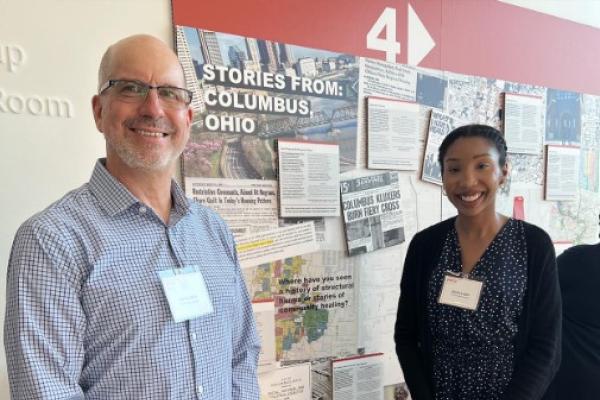Engaged Scholars: Harvey Miller

This article originally appeared on the Ohio State University Outreach and Engagement Website.
Engaged Scholars is a series highlighting Ohio State faculty who have made an impact in our communities through their community-engaged research and teaching.
Harvey J. Miller
Bob and Mary Reusche Chair in Geographic Information Science, Professor of Geography and Director of the Center for Urban and Regional Analysis
College of Arts and Sciences/Geography
Other affiliations:
- Courtesy Professor, City and Regional Planning program, Knowlton School of Architecture
- Faculty Affiliate, Sustainability Institute
- Faculty Affiliate, Translational Data Analytics Institute
- Affiliated Faculty, Center for Injury Research and Policy, Abigail Wexner Research Institute, Nationwide Childrens Hospital
My research and teaching are at the intersection of geospatial data analytics, urban science and sustainability science. A particular focus is sustainable mobility, resilient communities and the relationships between human mobility, environmental justice and wellness. I work with students, interdisciplinary collaborators and community partners to leverage new sources of georeferenced mobility, urban and social data to understand and improve the environmental, social and economic dimensions of human mobility within cities and regions.
Why is it important to engage the community in your research and teaching?
I am fortunate to be living though a scientific revolution. New geospatial data and technologies are completely changing our view of cities, giving us a richer view of how they operate and evolve. This is allowing us to move beyond 20th century urban science based on a simple, mechanistic view of cities as machines that can be engineered. We now recognize that cities are complex systems that require a more nuanced and sophisticated approach to policies and plans: they are more like gardens to be cultivated than machines to be engineered.
Also, in the past community engagement in scientific planning and policy was driven by a similar mindset: it was technocratic, top-down and one-way the experts knew what was best and can find optimal solutions to urban problems. We now recognize that many of the challenges facing communities are "wicked problems": multifaceted, intricate and value-laden, with no optimal solutions. Consequently, one-way, top-down dialogues are too limited to explore and understand the sustainability challenges facing communities. Novel geospatial data and technologies are fueling new approaches to better engagement and multi-lateral dialogues, using 21st century digital equivalent of the map one of the most profound technologies in the history of civilization.
What led you to the path of engaged scholarship? How did you get started?
I am trained as a geographer, so I am inclined to holistic, systems-thinking that is a natural fit with engaged scholarship. Joining Ohio State as a faculty in 2013 was a new beginning for me: the environment for interdisciplinary research at Ohio State is terrific there really are no barriers to collaboration here, other than time.
But what really set me on the path of engaged scholarship was being appointed director of the Center for Urban and Regional Analysis (CURA) in 2015. As CURA director, my job is to develop community-engaged scholarship and partnerships between the university and community stakeholders, spanning issues such as transportation, sustainability, social equity, public health, infant mortality and the opioid crisis. In the past, this included the City of Columbus, the Mid-Ohio Regional Planning Commission (MORPC), the Central Ohio Transit Authority (COTA), Ohio Department of Transportation (ODOT), the Central Ohio Trauma System (COTS), Franklin County Alcohol Drug and Mental Health Board, Jobs Ohio and Action for Children. These partnerships involve faculty and students from the College of Arts and Sciences, College of Engineering, College of Public Health, College of Social Work and the Wexner Medical Center and university entities such as the Kirwan Institute, the Sustainability Institute and the Translation Data Analytics Institute.
How has your scholarship benefited from engaging with community partners?
Engaging with community partners is a win-win situation. Our partners face crucial challenges and have well-grounded expertise and relationships in the community. They also have access to unprecedented data. What they often do not have is the capacity and time to fully leverage these novel data sources. I work with students and faculty who are well-trained in the scientific state-of-the art, crave opportunities to work on challenging problems and really want to make the world a better place. It's beautiful.
What has been a highlight of your community engagement experience?
It is hard to point to a single thing or event as a highlight, because I feel that successful community engagement is an ongoing process that requires persistence. I believe that CURA has been very successful over the years at shaping community conversations and thinking around crucial sustainability issues. This is not only because of our scholarship, but also our active and vigorous outreach program, including our well-attended webinar series where we have discussions with international and local experts on topics of interest to cities and regions in Ohio, and beyond.
What advice would you give to faculty and students who are interested in engaging the community in their scholarship?
You need to take the long view. Building trust with organizations and people in the community is not something that happens overnight. Organizations need to trust that you can deliver on your promises, and deliver on time. People in the community are used to professors parachuting in, saying "we are here to help!" and then disappearing when the funding is over. It takes time, patience and persistence to build trust, but trust is the foundation for everything.
